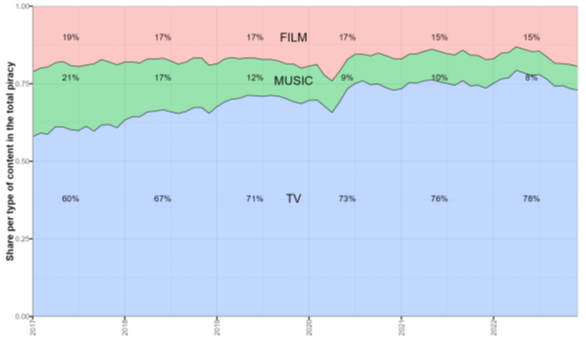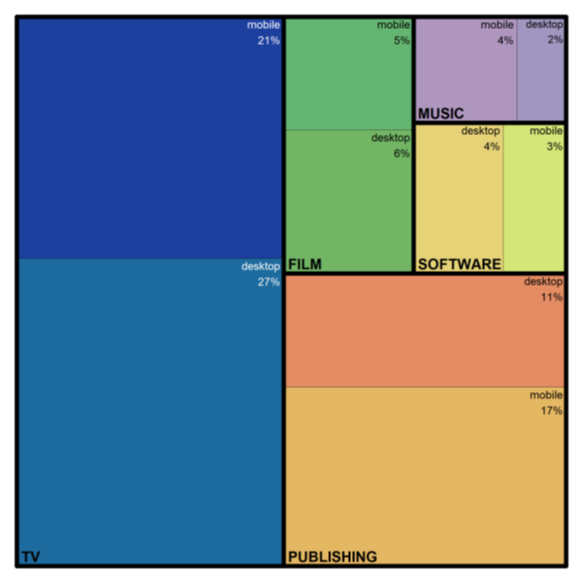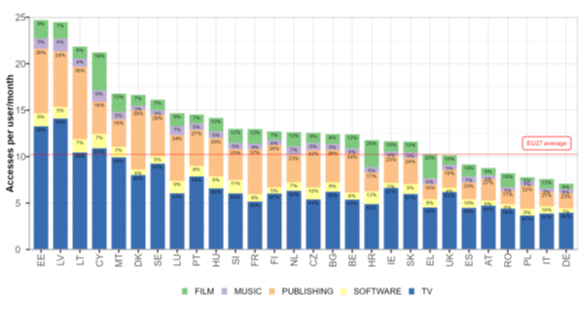EU STUDY: DOWNWARD TREND IN ONLINE PIRACY REVERSED LAST YEAR

The Internet is a phenomenon that makes our daily lives easier. However, besides the positive aspects offered, it also has its darker side. The negative features undoubtedly include digital piracy, which is the subject of a new study, Online Copyright Infringement in the European Union.
History of the concept of piracy
The word ‘piracy’ has a distant Indo-European root. Originally, the word had a completely different meaning. It meant an attempt, an endeavour or an experience. The word ‘peiratos’ referred to a coastal sea warrior. The current meaning of "sea thief" is therefore not too far removed from the original meaning. In ancient times, pirates were also seen as violators of order. According to the society of the time, their main characteristic was that they did not respect any property ownership generally accepted by society.
It is not surprising that the term has come to be used figuratively to refer to the theft of intellectual property, which now takes many forms. One of these is digital piracy, associated with the illegal use and dissemination of copyrighted content via storage and streaming platforms.
Negative impact on creators’ profits and content quality
Online piracy has a significant negative impact on creators and the entertainment industry, depriving them of the revenue needed to offset the high costs of production, whether it is for series, films, music, software, or publications. Another major problem is that illegal distribution undermines the quality of content. Pirated copies often do not provide the same quality and security, which affects the whole industry - and especially end users who are at risk of malware and poor-quality content.
The European Union Intellectual Property Office (EUIPO) has been dealing with the phenomenon of online piracy for a long time and has recently published a new study entitled Online Copyright Infringement in the European Union. The study focused on the analysis of illegal online consumption of protected TV, music, film, software and publishing content in EU Member States and the UK over the period 2017-2022. One of the points of the study was the general evolution of piracy.
General development of piracy since 2017
The last report concluded by saying that online piracy has slowly declined over the years until the end of 2020. According to this year’s study, piracy declined continuously from 2017 until early 2021, when the positive trend reversed. This is true not only for the European Union as a whole but also for most Member States. In 2022, piracy (in EU27) accounted for around 7 accesses per internet user per month. The good news is that this is still low compared to the peak level in March 2017.
Share per type of content in the total piracy
There are clear differences between individual types of digital piracy. The share of TV piracy has increased over the years, from around 59% to 73%, while the share of music piracy has decreased from 20% in 2017 to 9% in 2022. The share of film piracy has seen a slight decrease from 20% to 18% over the same period. The shares of each type are shown in the figure below.

Source: EUIPO
Annual piracy rate per capita: music content deviates from the trend
The total annual piracy rate per capita (i.e. the value for all content types) was -17.5% in 2018 and, after a continuous further decline during 2019-2021, it saw an increase of +13.3% in 2022. This overall growth rate of +13% is mainly driven by TV piracy, although film piracy has also contributed, albeit to a lesser extent.
The most significant decline in the annual per capita piracy rate for all types of content occurred in 2020, after which the decline moderated and then reversed in 2022.
Television content saw a decline in the annual per capita piracy rate of -10.7% in 2018, a slightly smaller decline of -9.1% in 2019, another significant decline of -22.9% in 2020, -6.9% in 2021, and a significant increase in the total per capita piracy rate is evident in 2022, with the study indicating +15.3%.
The annual per capita piracy rate for film was -20.3% in 2018, the decline continued at a more moderate pace in 2019, ending at -11.0%, the decline was even more pronounced in 2020 at -28.3%, and slowed to -18.0% in 2021. In 2022, the tide turned, and film content saw an increase of +17.2% in terms of annual per capita piracy rate.
Music content bucks this trend. It is the only type of content that has not seen a reversal in 2022. In 2018, there was an apparent significant decline of -34.5%, and this decline increased in subsequent years. It was -36.6% in 2019, -37.9% in 2020, only -3.7% in 2021, and the annual per capita piracy rate fell by a further -6.0% in 2022.
For publications and software, only 2022 values are available and are +37.1% for publications and +10.7% for software.
Piracy was affected by the COVID-19 pandemic
According to the results of the study, 2020 and 2021 showed significant deviations from all other years, albeit in different directions. While the start of the COVID-19 pandemic coincided with a 21% drop in piracy, the second quarter of 2021 showed an overall increase (for all content types) of more than 8%.
Comparison of access from desktops and mobile devices
The difference between a mobile and a desktop device is based on the operating system that connects to the pirate website. These devices can be mobile phones, tablets or other devices with a mobile operating system.
The results of the study showed a clear tendency to consume pirated music and publishing content on mobile devices, while in the case of access to TV, users prefer to access from desktops, although access from mobile devices is also significant. The overall ‘balance of power’ between mobile devices and desktops can be seen in the figure below:

Total 2022 EU27 piracy proportion per type of content, with split per device; Source: EUIPO
It is clear that over time, there has been a noticeable shift in favour of mobile devices. The trend observed from 2017 to mid-2020 shows a more significant decline in desktop piracy compared to piracy on mobile devices. However, the decline in piracy on mobile devices continued until the end of 2020. This can be attributed to the measures and lockdowns put in place by Member States during the crisis related to the COVID-19 pandemic, which resulted in people spending more time at home. The current situation seems to be very similar to the situation in 2017.
Differences in the type of pirated content and total consumption by country
Both the type of pirated content in individual countries and the total consumption of pirated content per internet user show considerable variation between Member States. The total number ranges from around 25 accesses per internet user per month in Estonia to around 7 in Germany. The four countries with the highest piracy rates are Estonia, Latvia, Lithuania and Cyprus, while the lowest rates are in Germany, Italy and Poland. The Czech Republic is roughly in the middle with 43% of TV piracy, 10% of software piracy, 32% of publishing piracy, 6% of music piracy and 9% of film piracy.

Source: EUIPO
Source: euipo.europa.eu



